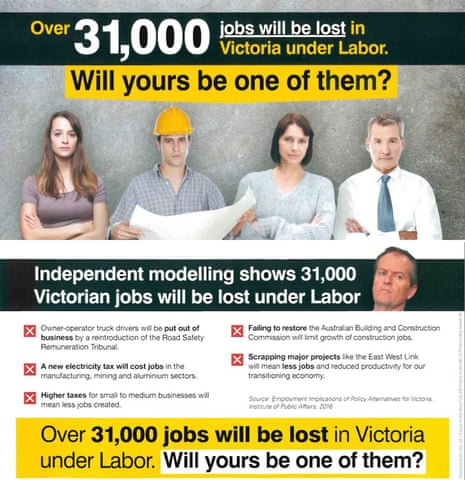The Coalition has used a contentious and highly qualified “independent” analysis from the Institute of Public Affairs to back an election flyer that claims “over 31,000 jobs will be lost in Victoria under Labor ... will yours be one of them?”.
The conservative thinktank has labelled its own calculations of “low to medium” reliability and says in the analysis “it is important to note that the estimates of Victorian jobs foregone or at risk, should major federal opposition policies be introduced, are highly conjectural by their nature and cannot be interpreted as definitive.”
The flyer, being distributed in Victorian marginal seats, says the job losses “will” be caused by “a new electricity tax”, “higher taxes for small to medium businesses”, the failure to restore the Australian Building and Construction Commission and scrapping major projects like the East West link.
The flyer, authorised by Victorian senator and Turnbull government minister senator Scott Ryan, cites in small print an IPA analysis as the basis for its job loss claims.
That analysis, found on the IPA website, reveals that almost 6,000 of the claimed job “losses” are new positions that might be “forgone” over the next decade because of Labor’s opposition to the government’s proposed company tax cut, something the think tank says is a “provisional” assessment that does not take into account the fact that Labor supports the small business tax cuts. The IPA says its own assessment of this employment impact is of “low to medium reliability”.
Another 10,160 job “losses” are asserted to be looming because of Labor’s climate change policies – a calculation also said it be of “low to medium reliability”. This appears to include all jobs in coal-fired electricity, all jobs at Alcoa’s aluminium smelter and another 7,200 manufacturing jobs, which the IPA asserts are “at risk”. The “analysis” does not mention potential new jobs in renewable industries.
The IPA does admit “quantifying the potential effects of Labor policy on employment in other Victorian manufacturing industries is difficult in the absence of modelling, however a small number of studies (admittedly, pertaining to different kinds of climate change policies) provide some rough indication of the extent to which manufacturing workers are potentially made vulnerable under the policies proposed by the opposition.”
The IPA also asserts that another 9,065 Victorian jobs will be lost because Labor wants to reinstate the Road Safety Remuneration Tribunal, a claim it says has “low” reliability.
And it asserts another 6,000 construction jobs will be “lost” from the already-shelved East West link road.
The IPA says “although it is highly likely that infrastructure construction employees would be otherwise assigned to works for other projects in Victoria and elsewhere, it is assumed that the 6,000 jobs specifically for the East-West Link project would be foregone upon a change of government at the federal level.”
“The purpose of this analysis is to provide tentative estimates of the magnitude of employment effects associated with selected federal opposition policies for the state of Victoria,” IPA director of policy Simon Breheny says.
And he flags that “further IPA analysis of announced election policies across Australia will be released in the coming weeks.”
